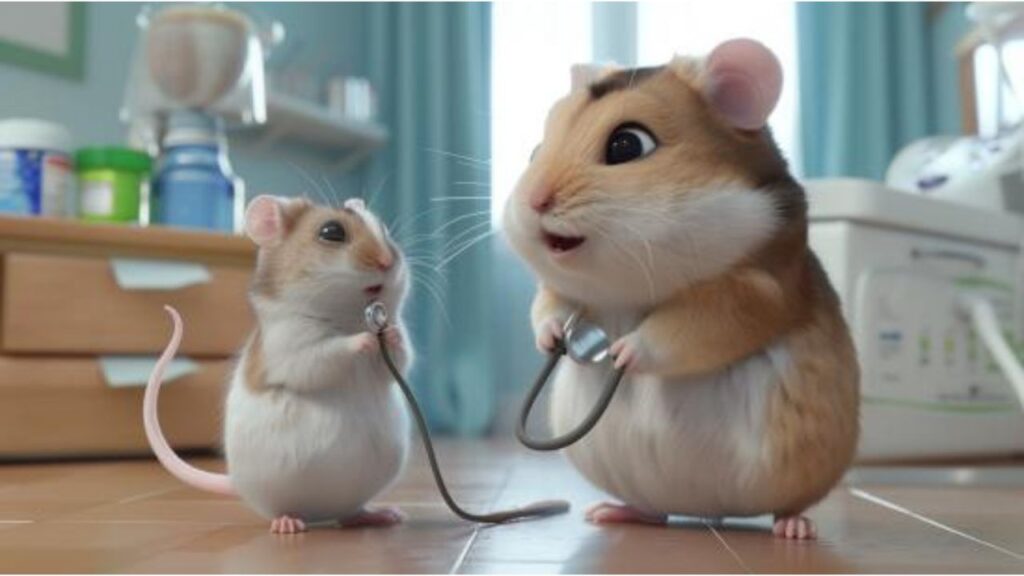Hello, fellow hamster enthusiasts! It’s SmartyPaws here, your go-to guide for everything hamster. Today, we’re embarking on a crucial journey into the world of hamster first aid. As lovable and resilient as our furry friends can be, they’re not immune to accidents and health issues. Knowing how to respond in these situations is not just helpful; it’s essential for their well-being.
Importance of Knowing Hamster First Aid
The importance of understanding hamster first aid cannot be overstated. Just like humans, hamsters can encounter health emergencies that require immediate attention. Whether it’s a minor injury from an adventurous escapade or a sudden health issue, your ability to act swiftly and knowledgeably can significantly impact your hamster’s chances for a quick and full recovery. Equipping yourself with hamster first aid knowledge ensures you’re prepared to protect your pet from further harm and stabilize their condition until professional veterinary care is available.
Common Reasons Hamsters May Need First Aid
Hamsters are curious creatures, and their adventures can sometimes lead to mishaps. Common reasons your hamster might need first aid include falls, especially from their climbing toys or when being handled; cuts or scrapes from exploring their cage or encountering sharp objects; and health issues such as choking, heatstroke, or symptoms of cold shock. Additionally, hamsters can suffer from sudden illnesses like diarrhea, respiratory problems, or infections, all of which might require immediate first aid to prevent complications.
How Being Prepared Can Make a Difference
Being prepared for emergencies involves more than just having a first aid kit; it’s about knowing how to use it. Understanding the signs of distress in your hamster, how to administer first aid, and when to seek veterinary assistance can make a monumental difference in the outcome of an emergency situation. Preparedness ensures you remain calm and focused, allowing you to provide the best possible care for your pet in those critical moments. It also minimizes the risk of panic-induced mistakes, ensuring your actions contribute positively to your hamster’s health and safety.
In essence, the knowledge and preparedness for hamster first aid are indispensable tools in your pet care toolkit. They empower you to act decisively and effectively, ensuring that your hamster receives the care it needs when every second counts. Stay tuned as we dive deeper into setting up your hamster first aid kit, recognizing signs of distress, handling common emergencies, and much more. Together, we’ll ensure you’re equipped to be the best hamster guardian you can be.
Setting Up Your Hamster First Aid Kit

Hello, fellow hamster enthusiasts! SmartyPaws here, guiding you through the vital process of preparing for the unexpected. Today, we’re diving into how to set up a comprehensive hamster first aid kit. Whether you’re a new hamster parent or a seasoned caretaker, having a first aid kit specifically for your furry friend is crucial. Let’s ensure you’re equipped to handle common emergencies with confidence and care.
Essential Supplies
First and foremost, your hamster first aid kit should be stocked with all the essentials needed to address minor injuries, symptoms of illness, or immediate care before you can get professional veterinary help. Here are some must-haves:
- Sterile Gauze and Bandages: For covering wounds or stopping minor bleeding.
- Scissors and Tweezers: Scissors for cutting bandages to size and tweezers for removing any debris or splinters from wounds.
- Antiseptic Wipes or Spray: To clean wounds and prevent infection. Ensure it’s safe for use on pets.
- Cotton Buds and Balls: For applying medications or cleaning small areas.
- Latex-Free Gloves: To keep the area clean and prevent the spread of germs.
- Syringe (Without Needle): For administering oral medications or hydrating a hamster that isn’t drinking.
- Thermometer: Specifically designed for pets, to check your hamster’s temperature if you suspect fever or illness.
- Flashlight: To help inspect your hamster’s body for injuries or abnormalities in low light conditions.
- Emergency Contact Information: Keep a list of emergency vet contacts and any medication instructions handy.
Storage and Accessibility
Having the right supplies is one thing; storing them for easy accessibility is another. Choose a small, portable container with compartments or dividers to keep items organized and easily identifiable. A plastic storage box with a secure lid is ideal, as it’s lightweight, durable, and easy to clean.
Place your first aid kit in a consistent and accessible location, ideally near where your hamster lives but out of their reach. This ensures you can quickly grab it in case of emergency without wasting precious time searching.
Regular Maintenance
Your hamster’s first aid kit requires regular checks to ensure everything inside is up to date and in good condition. Here’s how to maintain it:
- Check Expiry Dates: Regularly check and replace items like antiseptic wipes or sprays that have expiration dates.
- Inventory Checks: After any use, replenish used items to ensure the kit is always fully stocked.
- Inspect for Damage: Look over all tools and containers for any damage or wear that could compromise their effectiveness.
By following these guidelines, you’ll have a well-prepared hamster first aid kit, ready to tackle minor emergencies and care needs. Remember, while a first aid kit is essential, it’s not a substitute for professional veterinary care in serious situations. Always consult your vet when in doubt.
Recognizing Signs of Distress in Hamsters

Hey there, hamster heroes! SmartyPaws back at it, this time with a crucial guide to recognizing when your fluffy friend might be in distress. Knowing the signs can be the difference between a minor hiccup and a serious emergency. Let’s dive into how to spot trouble and what actions to take to ensure your hamster’s health and happiness.
Physical Symptoms
Physical symptoms are often the most noticeable indicators that something is amiss with your hamster. Keep an eye out for the following:
- Wet Tail: This condition, characterized by a soiled and wet rear end, can be a sign of diarrhea or a more serious condition like proliferative ileitis, especially in younger hamsters.
- Labored Breathing or Wheezing: This could indicate respiratory issues, which are not uncommon in hamsters and require immediate veterinary attention.
- Limping or Unwillingness to Move: Such behaviors could suggest injury, arthritis, or an infection.
- Unusual Lumps or Swellings: These could be tumors or abscesses, both of which necessitate a vet visit.
- Loss of Fur or Skin Abnormalities: Look for patches of lost fur, redness, scaling, or scabs, as these can indicate skin infections or parasites.
Behavioral Changes
Behavioral changes can sometimes be the first clue that your hamster isn’t feeling well. Be aware of:
- Decreased Activity: If your normally energetic hamster is lethargic or sleeping more than usual, it could be a sign of illness.
- Loss of Appetite or Changes in Eating Habits: A sudden disinterest in food or water is a red flag that shouldn’t be ignored.
- Aggressiveness or Irritability: If your typically docile hamster suddenly becomes aggressive, it might be in pain or distress.
- Hiding More Than Usual: While hamsters enjoy their solitude, excessive hiding can indicate fear, stress, or feeling unwell.
Immediate Actions
When you notice signs of distress in your hamster, quick and appropriate actions can greatly impact their recovery. Here’s what to do:
- Isolate the Sick Hamster: If you have multiple hamsters, isolate the one showing signs of distress to prevent the potential spread of illness and reduce stress on the sick individual.
- Create a Comfortable Environment: Ensure their cage is clean, warm, and quiet to help reduce stress and promote recovery.
- Observe and Document Symptoms: Take note of all the symptoms you observe, including when they started and how they progress. This information is invaluable to your vet.
- Avoid Stressful Situations: Try to minimize handling and stressful situations that could exacerbate your hamster’s condition.
- Consult a Veterinarian: If symptoms persist or worsen, consult a veterinarian as soon as possible. Early intervention is key to a successful recovery.
By staying alert to these signs of distress and knowing how to respond, you’re taking a big step towards ensuring your hamster’s well-being. Remember, you’re their first line of defense against illness and injury, so stay observant, proactive, and always ready to act in your pet’s best interest.







